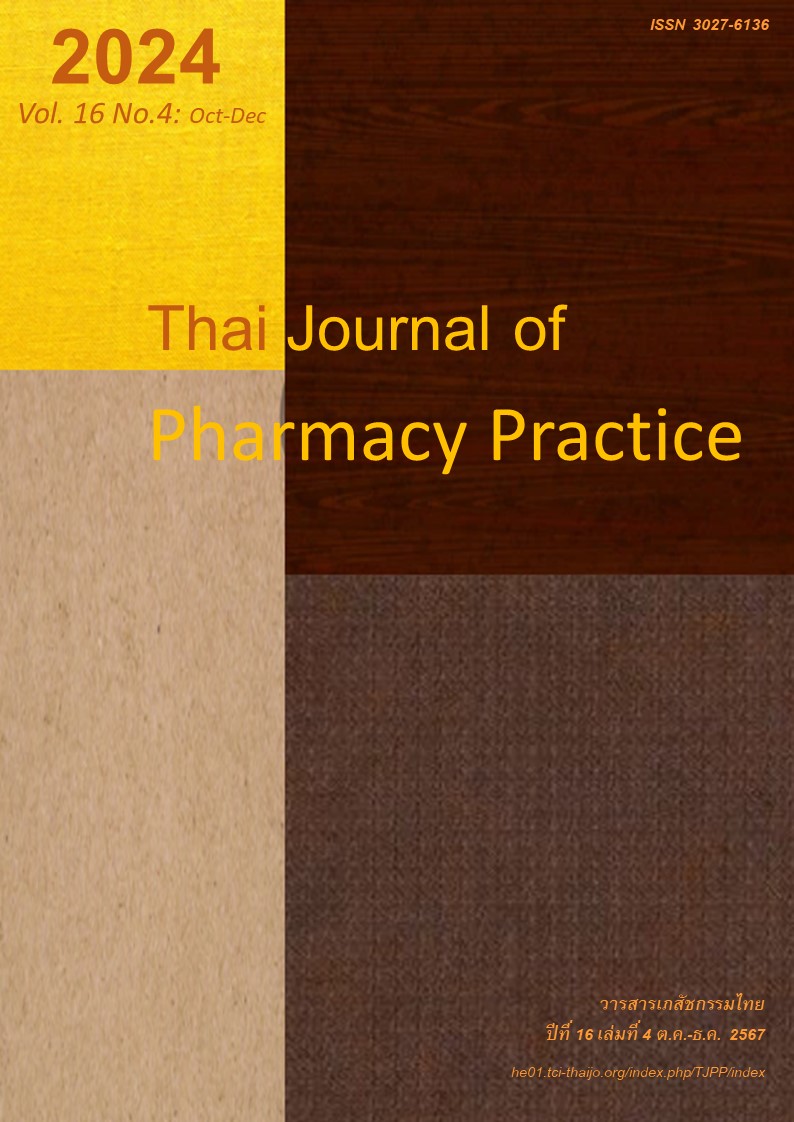ผลกระทบของการบริบาลเภสัชกรรมต่อคุณภาพชีวิตของผู้ป่วยมะเร็งเต้านมระยะแรก ในช่วงการได้รับสูตรยาที่มียากลุ่มแทคเซนเป็นส่วนประกอบ
Main Article Content
บทคัดย่อ
วัตถุประสงค์: เพื่อเปรียบเทียบคุณภาพชีวิตและระดับของความรุนแรงของอาการไม่พึงประสงค์จากการใช้ยาในผู้ป่วยมะเร็งเต้านมระยะแรกในช่วงที่ได้รับยาที่มียากลุ่มแทคเซนเป็นส่วนประกอบ ระหว่างกลุ่มที่ได้รับการบริบาลทางเภสัชกรรมกับกลุ่มที่ได้รับการบริการตามมาตรฐาน วิธีการ: การวิจัยนี้เป็นเป็นการศึกษาเชิงทดลองแบบสุ่มชนิดมีกลุ่มควบคุมในผู้ป่วยมะเร็งเต้านมระยะแรกในช่วงที่ได้รับยาที่มียากลุ่มแทคเซนเป็นส่วนประกอบ ณ โรงพยาบาลนพรัตนราชธานี ตัวอย่างได้รับการจัดสรรแบบสุ่มเข้ากลุ่มที่ได้รับการบริบาลทางเภสัชกรรม (กลุ่มศึกษา) และกลุ่มได้รับการบริการตามมาตรฐาน (กลุ่มควบคุม) ด้วยอัตราส่วน 1:1 การวัดคุณภาพชีวิตใช้แบบประเมินคุณภาพชีวิต FACT-B version 4 ฉบับภาษาไทย และใช้เกณฑ์ CTCAE version 5 ประเมินความรุนแรงของอาการไม่พึงประสงค์จากการใช้ยา ผลการวิจัย: ผู้เข้าร่วมการศึกษา 49 รายเป็นกลุ่มที่ได้รับการบริบาลทางเภสัชกรรม 25 ราย และกลุ่มที่ได้รับการบริการตามมาตรฐาน 24 ราย หลังได้รับยาเคมีบำบัด พบว่า กลุ่มที่ได้รับการบริบาลทางเภสัชกรรมมีคุณภาพชีวิตโดยรวมเพิ่มขึ้นจากระดับคุณภาพชีวิตเดิมอย่างมีนัยสำคัญ (99.71 ± 11.99 เทียบกับ 108.66 ± 12.73; P < 0.001) และค่า Trial Outcome Index (TOI) ได้เพิ่มขึ้นอย่างมีนัยสำคัญ (61.96 ± 8.18 เทียบกับ 68.40 ± 9.21; P < 0.001) นอกจากนี้ ผู้ป่วยที่ได้รับการบริบาลทางเภสัชกรรมพบการเกิดอาการชาตามปลายประสาทที่มีความรุนแรงระดับ 3 ขึ้นไปน้อยกว่ากลุ่มที่ได้รับการบริการตามมาตรฐาน (ร้อยละ 0 เปรียบเทียบกับ ร้อยละ 16.7; P = 0.017) สรุป: การบริบาลทางเภสัชกรรมที่นำแบบประเมินคุณภาพชีวิตด้านสุขภาพมาเป็นเครื่องมือในการติดตามอาการไม่พึงประสงค์จากการใช้ยา สามารถเพิ่มคุณภาพชีวิต และลดความรุนแรงของอาการไม่พึงประสงค์ในผู้ป่วยมะเร็งเต้านมระยะแรกในช่วงได้รับยาเคมีบำบัดที่มีกลุ่มแทคแซนเป็นส่วนประกอบ
Article Details

อนุญาตภายใต้เงื่อนไข Creative Commons Attribution-NonCommercial-NoDerivatives 4.0 International License.
ผลการวิจัยและความคิดเห็นที่ปรากฏในบทความถือเป็นความคิดเห็นและอยู่ในความรับผิดชอบของผู้นิพนธ์ มิใช่ความเห็นหรือความรับผิดชอบของกองบรรณาธิการ หรือคณะเภสัชศาสตร์ มหาวิทยาลัยสงขลานครินทร์ ทั้งนี้ไม่รวมความผิดพลาดอันเกิดจากการพิมพ์ บทความที่ได้รับการเผยแพร่โดยวารสารเภสัชกรรมไทยถือเป็นสิทธิ์ของวารสารฯ
เอกสารอ้างอิง
Sung H, Ferlay J, Siegel RL, Laversanne M, Soerjo mataram I, Jemal A, et al. Global cancer statistics 2020: GLOBOCAN estimates of incidence and mortality worldwide for 36 cancers in 185 countries. CA Cancer J Clin 2021; 71: 209-49.
National Cancer Institute. Hospital-based cancer registry 2020 [online]. 2020 [cited May 3 2022]. Available from: www.nci.go.th/e_book/hosbased_256 3/index.html.
Cardoso F, Kyriakides S, Ohno S, Penault-Llorca F, Poortmans P, Rubio IT, et al. Early breast cancer: ESMO clinical practice guidelines for diagnosis, treatment and follow-up. Ann Oncol 2019; 30: 1194-220.
Paoin P, Rungwang Y, Tairsakul R. Quality of life among the breast cancer patients receiving modified radical mastectomy (MRM) and chemotherapy. J Hlth Sci Res 2010; 4: 28-37.
Whelan TJ, Levine M, Julian J, Kirkbride P, Skingley P. The effects of radiation therapy on quality of life of women with breast carcinoma: results of a randomized trial. Cancer 2000; 88: 2260-6.
National Comprehensive Cancer Network. Breast [online]. 2022 [cited May 3 2022]. Available from: www.nccn.org/professionals/physician_gls/pdf/breast.pdf.
Al-Mahayri ZN, Patrinos GP, Ali BR. Toxicity and pharmacogenomic biomarkers in breast cancer chemotherapy. Front Pharmacol. 2020; 11: 445. doi:10.3389/fphar.2020.00445.
De Iuliis F, Salerno G, Taglieri L, Scarpa S. Are phar macogenomic biomarkers an effective tool to predict taxane toxicity and outcome in breast cancer patients? Literature review. Cancer Chemother Pharmacol 2015; 76: 679-90.
Sledge GW, Mamounas EP, Hortobagyi GN, Burstein HJ, Goodwin PJ, Wolff AC. Past, present, and future challenges in breast cancer treatment. J Clin Oncol 2014; 32: 1979-86.
Korpusilp S, Pongmesa T. Quality of life of breast cancer women during chemotherapy with fluorouracil, doxorubicin and cyclophosphamide (FAC) regimen. Songklanakarind Medical Journal 2017; 35: 373-84.
Subongkot S, Srisawat S, Johns P N, Sookprasert A. Outcome of chemotherapy counseling in oncology patients by pharmacist. Isan Journal of Pharmaceu- tical Sciences. 2009; 5: 34-45.
Cipolle RJ, Starand LM, Morley PC. Pharmaceutical care practice: the patient-centered approach to medication management services. 3rd ed. New York: McGraw-Hill; 2012.
Supapaan T, Amornphetsathaporn J, Jansiri N, Kam-Ing N, Janthapim P, Chompoopuen P. Narrative literature review: outcome measurement of hospital pharmaceutical care in Thailand. Isan Journal of Pharmaceutical Sciences. 2021; 17: 1-29.
Hepler CD, Strand LM. Opportunities and responsi bilities in pharmaceutical care. Am J Hosp Pharm 1990; 47: 533-43.
Fujii H, Ueda Y, Hirose C, Ohata K, Sekiya K, Kita hora M, et al. Pharmaceutical intervention for adverse events improves quality of life in patients with cancer undergoing outpatient chemotherapy. J Pharm Health Care Sci 2022; 8: 8 doi:10.1186/s4078 0-022-00239-w.
Liekweg A, Westfeld M, Braun M, Zivanovic O, Schink T, Kuhn W, et al. Pharmaceutical care for patients with breast and ovarian cancer. Support Care Cancer 2012; 20: 2669-77.
Trevittaya P. Concepts of quality of life. J Assoc Med Sci 2016; 49: 171-84.
Bottomley A, Reijneveld JC, Koller M, Flechtner H, Tomaszewski KA, Greimel E, et al. Current state of quality of life and patient-reported outcomes research. Eur J Cancer 2019; 121: 55-63.
Turner-Bowker DM, Hao Y, Foley C, Galipeau N, Mazar I, Krohe M, et al. The use of patient-reported outcomes in advanced breast cancer clinical trials: a review of the published literature. Curr Med Res Opin 2016; 32: 1709-17.
Chuenchom O, Chuemongkon W, Rattanacheeworn K, Kasemsakkarin W. The Comparison of the quality of life in patients with early stage breast cancer between using FAC and AC-T regimens in Marengrai roke clinic at Maharat Nakhon Ratchasima Hospital. Isan Journal Pharmaceutical Sciences 2014; 10: 214 -27.
Mokhtari-Hessari P, Montazeri A. Health-related quality of life in breast cancer patients: review of reviews from 2008 to 2018. Health Qual Life Out- comes 2020; 18: 338. doi:10.1186/s12955-020-01591-x.
Lovelace DL, McDaniel LR, Golden D. Long-term effects of breast cancer surgery, treatment, and survivor care. J Midwifery Womens Health 2019; 64: 713-24.
Wongkray S, Danwilai K DT. Impact of pharmaceutical care on quality of life in breast cancer patients: a randomized controlled trial. Thai Journal of Pharmacy Practice 2019; 11: 827-39.
Faul F, Erdfelder E, Buchner A, Lang A-G. Statistical power analyses using G*Power 3.1: Tests for correlation and regression analyses. Behav Res Methods 2009; 41: 1149-60.
Common terminology criteria for adverse events (CTCAE) Ver 5.0 Department of health and human
services [online]. 2017 [cited April 5, 2022]. Available from: ctep.cancer.gov/protocoldevelopment/electro nic_applications/docs/ctcae_v5_quick_reference_5x7.pdf.
Brady MJ, Cella DF, Mo F, Bonomi AE, Tulsky DS, Lloyd SR, et al. Reliability and validity of the Functional Assessment of Cancer Therapy-Breast quality-of-life instrument. J Clin Oncol 1997; 15: 974-86.
Jaeschke R, Singer J, Guyatt GH. Measurement of health status. Ascertaining the minimal clinically important difference. Control Clin Trials 1989; 10: 407-15.
Eton DT, Cella D, Yost KJ, Yount SE, Peterman AH, Neuberg DS, et al. A combination of distribution- and anchor-based approaches determined minimally important differences (MIDs) for four endpoints in a breast cancer scale. J Clin Epidemiol 2004; 57: 898-910.
Clavarezza M, Del Mastro L, Venturini M. Taxane-containing chemotherapy in the treatment of early breast cancer patients. Ann Oncol 2006; 17: vii22-vii6.
Intamnu S. Effects of counseling and monitoring of adverse drug events (ADE) in patients with breast and colorectal cancer receiving chemotherapy in Nangrong hospital. Thai Journal of Pharmacy Prac- tice 2021; 13: 202-13.
Hong-Li C, Xiao-Chun W, Jiang-Bin W, Jing-Bo Z, Yao W. Quality of life in patients with breast cancer and their rehabilitation needs. Pak J Med Sci 2014; 30: 126-30.


